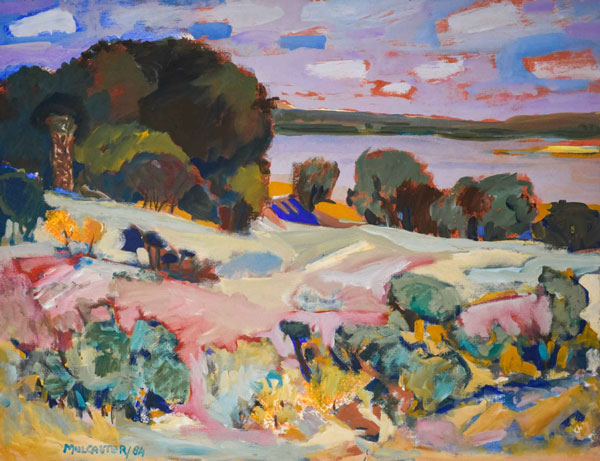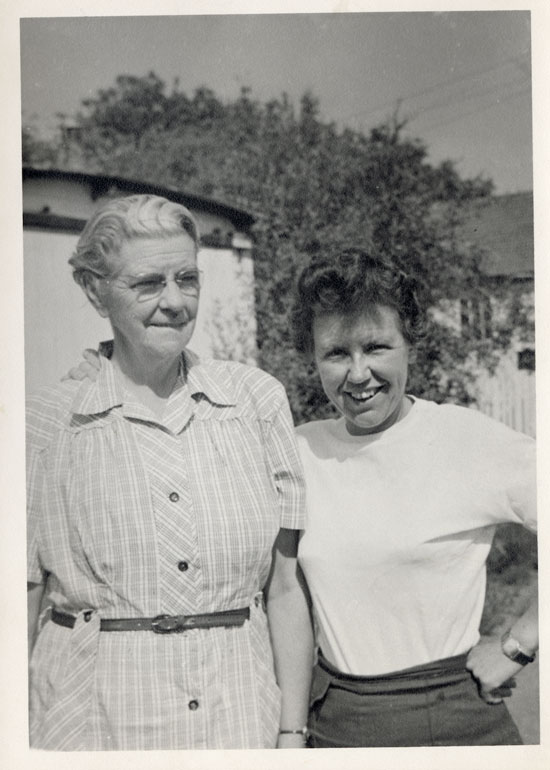University of Saskatchewan (USask) graduate Wynona Croft Mulcaster (BA’43) played an integral role in shaping the history of art and art education in the province.
Now, eight years after her death in 2016 at the age of 101, an exhibition at the Kenderdine Art Gallery is paying tribute to her legacy. The show—titled Nonie, a reference to Mulcaster’s nickname—features 20 paintings on canvas and paper. Selected by curator and fellow USask graduate Leah Taylor (BFA’04), the paintings depict two places Mulcaster considered home: Saskatchewan, where she was born in 1915, and San Miguel de Allende, Mexico, where she lived for about 40 years before her death.
“I think the work is quite stunning,” said Taylor, who chose to focus on Mulcaster’s landscape work for Nonie.

“She did paint in both Mexico and Saskatchewan, as well as other prairie places. Throughout the exhibition, you’ll see mostly those two places—and you can’t always tell which one is which,” Taylor said. “That’s what I really liked about the selection and why I focused on landscape. Sometimes it does look like a dry desert; other times it looks like the prairies at spring or late fall.”
As she looked through Mulcaster’s work, Taylor noticed Mulcaster’s ability to take risks with her brushwork, creating “an almost Fauvist quality to her painting style, but also some abstraction.”

“It’s sort of unexpected use of colour,” said Taylor. “There will be a lot of purples in the landscape, which isn’t a colour that often is really visible to the eye when you’re outside.”
While many of the pieces featured in Nonie were painted in the 1980s, Mulcaster created artwork throughout her life. As a teenager, she combined her interest in art with her love of horses when she studied with Ernest Lindner, an influential artist and art educator in Saskatchewan who received an honorary Doctor of Laws from USask in 1972. Mulcaster began the art lessons with Lindner, a renowned landscape artist, with the goal of being able to draw a horse. Mulcaster later went on to start the Saskatoon Pony Club in 1945, after moving to the city from her home community of Prince Albert, and taught riding until 1973. As a result, she was inducted into the Saskatoon Sports Hall of Fame in 1994 for her contributions to horseback riding.
“Animals and nature were always a big love for her,” Taylor said.
Fittingly, as Mulcaster’s artistic practice evolved over the years, she continued to draw inspiration from the natural world around her. Starting in the 1930s, she took part in the famed Emma Lake Artists’ Workshops, which were held at USask’s Emma Lake Kenderdine Campus in the boreal forest in northern Saskatchewan. The workshops attracted many well-known artists and art critics over decades, including USask graduates such as Dorothy Knowles (BA’48), who learned to paint in the woods at Emma Lake.
It was in 2006 at an Emma Lake reunion where Taylor and Mulcaster first met. At the time, Mulcaster was being honoured by her peers. Meeting Mulcaster and chatting with her over dinner was a “profound” experience for Taylor.

“She really highlighted some of the early things she had done, especially with being one of the co-founders of the Emma Lake Artists’ Workshops, and just her love for that landscape and painting,” Taylor recalled. “She was, I think, 91 when I met her and spoke with her, and she also was still incredibly fiery. She was still painting, she lived full time in Mexico, and she still rode horses every day.”
As Taylor and Mulcaster chatted, Mulcaster shared some stories about her earlier days as a painter in Saskatchewan and at Emma Lake. Mulcaster’s experiences “foregrounded how she was quite a pioneer as a female artist with that group,” said Taylor. The conversation also left Taylor feeling that there hadn’t been enough of a spotlight shone on Mulcaster’s artwork.
“She was quite vivacious, tough, industrious—and she still communicated all of those things in her nineties,” said Taylor. “But I do feel like a lot of the male painters overshadowed the female painters from that period—particularly the Emma Lake Artists’ Workshops—not in their production of work, but in their ability to then have exhibitions.”
Taylor recalls a story that Mulcaster shared about her early days as an artist. Mulcaster told Taylor that when she arrived at Emma Lake, she didn’t have a place to paint, and she wasn’t afforded the space of her male colleagues. Rather than leave, however, Mulcaster remained undaunted.
“She came back with her own supplies—like wood, a hammer, nails—and built herself this studio shack there,” said Taylor.
“She literally inserted herself into this space. It was a bold feminist move, I thought, and also spoke to her nature. She could do it all.”

Throughout her life, Mulcaster was admired by her peers for this ferocity, as well as for her role in helping to pave the way for generations of Saskatchewan artists. Starting in 1937, she taught art to schoolchildren in Prince Albert and rural Saskatchewan, and later taught art at the Saskatchewan Teachers’ College in Saskatoon, where she took on the role of director of art education. In 1946, Mulcaster studied at the Banff School of Fine Arts, and from 1964 to 1977 she taught painting at USask as an associate professor in the Department of Visual Art. Her students included artists such as Henry Bonli, Robert Murray, Otto Rogers, and Allen Sapp.

After earning her Bachelor of Arts degree at USask in 1943, Mulcaster studied at the Instituto Allende, a visual arts school in Mexico, where she earned a master’s degree in fine arts in 1976. A year prior, in 1975, her artwork was featured in the exhibition Major Saskatchewan Artists at the Mendel Art Gallery in Saskatoon. In 1984, her work was the focus of another exhibition at the Mendel, titled Wynona Mulcaster: A Survey, 1973-1982.
In 2015, in celebration of her 100th birthday, the Mann Art Gallery in Prince Albert held an exhibition of Mulcaster’s work. Many of the paintings that are currently featured in Nonie were selected from the permanent collection of the Mann Art Gallery, to which Mulcaster donated dozens of pieces before her death. In 1993, Mulcaster received the Saskatchewan Arts Board Lifetime Award for Excellence in the Arts. Her artwork is also included in a current exhibition at Remai Modern, called Views from the Blue House: The Remai Modern Collection.
“She had a legacy of influencing Saskatchewan artists,” said Taylor, who wants to continue to shine a light on artists such as Mulcaster and Knowles so that younger artists and art students can become more familiar with the women’s work.
“We’re kind of carving out a new history where these female painters, such as Nonie and Dorothy Knowles, are being reintroduced, in many ways, to a new public.”
Nonie opened on Jan. 26, 2024, at the Kenderdine Art Gallery, located in the Agriculture Building on USask’s main Saskatoon campus. The exhibition will remain on view until April 19, 2024.
Together we will support and inspire students to succeed. We invite you to join by supporting current and future students' needs at USask.
Article re-posted on .
View original article.
